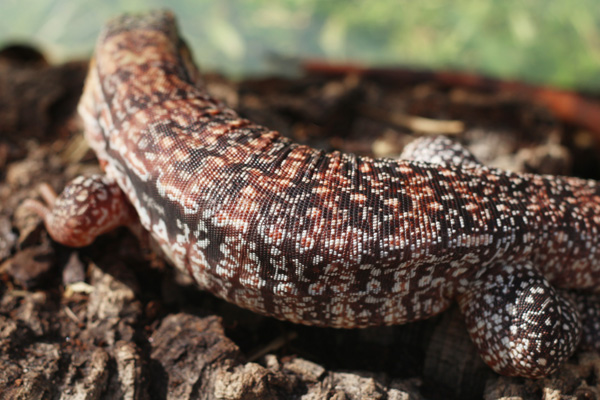This is Part II in my three part documentation of my first successful panther chameleon breeding. This one will focus primarily on the eggs, from beginning to end, the changes they underwent, and how I went about caring for the clutch as it developed.
Following the successful mating on November 28, 2011, the female laid 24 eggs on December 18-24, 2011 while I was out of town, just shy of 4 weeks after mating. She laid the eggs in a plant pot that measures 13" deep by 11" across at the top, filled to the top with moist, organic potting soil. She buried them all the way at the bottom of the pot, as is typical.
*NOTE - Females need somewhere to dig and bury their eggs when they are ready or they will succumb to a condition known as egg-binding, in which the female is no longer able to lay the eggs and will die unless immediate veterinary assistance is provided. Not enough calcium in the diet and other nutritional/health issues will also prevent a female from laying eggs. Refer to Part I of this breeding blog series for more information.
I very carefully and slowly scooped dirt from the laying pot until I uncovered the first egg. Then, with a sterilized set of tweezers I began removing each egg and placing it in the incubating container the way in which it was laid (that is, I do not roll them around). I used tweezers because the oil on your fingers can clog the outside of the egg and make air exchange difficult or impossible. Powder-free gloves are also good. I continued this process until every egg was excavated and they were all neatly lined up in the laying container.
THE CONTAINER - Something like a tupperware container with a tight lid will work the best for incubating the eggs. It does not need to be a very deep one, so the kind that are used to store sandwiches are generally the best. The incubating medium can be something like vermiculite, perlite, or Superhatch, etc. but it all needs to be moistened to the point where you can only squeeze a single drop or two from a fist of it. This will keep the humidity high in the container. A pin hole can be made in the container for air exchange but you can also simply open it once every few weeks for a moment. You may have to re-mist the media to maintain the humidity very high (but do not spray the eggs directly).
 |
| December 28 - Just a few days after being buried in soil, I dug them up and placed them in the incubating container with moist vermiculite. |
The rest is just waiting, unfortunately!
Lots and lots of waiting....
 |
The eggs after 4 months of incubation. They have grown a little bit! |
 |
| This photo and the one above show the eggs at 5 months of incubation, first compared in size to an American quarter and then with a 50c Euro, for my European friends and readers. |
 |
| Here are the eggs at 7 months of incubation. One egg has dramatically increased in size, for unknown reasons. |
 |
| By month 9 of incubation, the eggs are showing much more dramatic signs of hatching. The eggs are starting to show crackling and transparency, both of which are good signs. |
But because this is not the part that deals with babies (or neonates), we will continue to see how the remaining eggs changed and developed as more hatchlings emerged. On October 8, just 2 days following the hatching of the first baby, the remaining eggs underwent more dramatic changes. It is recommended to leave any hatchlings in the bin with the eggs for a short while before being removed, as it is believed that the hatchlings must signal the others to hatch by some method not yet understood - it may be pheromones or it may just by touch, but it seems to help move things along.
So on October 8 several of the eggs began to sweat and others became much more transparent.
 |
| On October 8 a second baby pips the egg shell and sits, waiting to emerge completely. |
By October 11, several more babies have hatched and the ones that are about to look more and more transparent. A couple towards the top shrank and hardened, which in this case meant that the eggs weren't going to hatch.
NOTES.
- In the case of this clutch, some of the eggs did shrink and harden, and then not hatch. Of the 24 eggs I had at the beginning, 3 proved not to be fertile. Upon dissection of some of these hardened eggs some had fully-formed babies that never hatched and others were duds, full of yellow jelly. Why these eggs never hatched probably had to do with the humidity perhaps not being as high as it should have been. I may have been able to help them survive had I cut the eggs open myself but I didn't want to for two reasons: 1. I did not want to risk injuring the babies in the process, since they are so tiny. My scalpel could have cut them and injured them seriously if my hand slipped or was not gentle enough. And 2. because I did not want to help hatchlings that perhaps just weren't strong enough to survive, when the other half of the eggs hatched quickly and without help.
- It was recommended to me that empty egg shells remain in the container with the others, perhaps because they release pheromones or other signals that stimulate the other eggs to hatch.
If I had to do this over again, there are a few things I would change slightly to improve my hatch rate. But at this time I am pleased with the very manageable number of hatchlings that resulted from this clutch, which means that I will be less overwhelmed when learning how to raise and care for them until they go to their new homes.
Part III, on raising the hatchlings, will follow shortly.




















